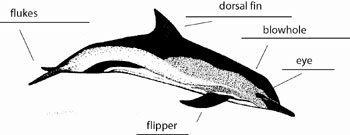Gray's paradox was originated by the zoologist James Gray in 1936 (J. Exp. Biol. 13: 192–199, 1936). The paradox questioned how a dolphin is able to swim fast (~10.1 meters per second according to his calculations) with what he saw as a limited ability to generate that much power. Therefore, he concluded that dolphins must have some mechanism or adaptation to reduce drag (Davidson College).
More recently, Dr. Frank Fish (West Chester University, Pennsylvania) was quoted in The Scientist saying, “To resolve the paradox was to assume that flow over the dolphin’s body is laminar, meaning that the particles all move parallel to one another and to the skin, when everything said it would be turbulent. The argument brought forth ideas that the dolphin has some adaptations in the skin to smooth out the flow.” Rather, Dr. Fish showed in 1993 that the muscular tails and flexible flukes of dolphins may be able to create sufficient propulsion for swimming fast using a hydrodynamic model (J Exp Biol, 185:179-93, 1993). While researchers can measure thrust using digital particle image velocimetry for small fish, to test this on large fish or dolphins was not possible at that time. This technique uses a water-filled tank that contains glass microbeads which can be illuminated with laser beams allowing researchers to see the beads move as the fish swim through them using high-speed videos. According to Dr. Fish however, “there’s no chance anyone would let you throw in glass beads and shine laser beams at dolphins. It’s way too risky.”
 Image from The Scientist. COURTESY OF FRANK E. FISH; TIM WEI (INSET IMAGE)
Image from The Scientist. COURTESY OF FRANK E. FISH; TIM WEI (INSET IMAGE)
Instead, Dr. Fish teamed with engineer Dr. Timothy Wei (University of Nebraska) who has measured propulsion in Olympic swimmers as they travel through a curtain of air bubbles. The above image of a dolphin fluke was captured using a bubble curtain and digital particle image velocimetry. The research team discovered that the dolphins are able to generate up to 3.2 horsepower (2380 watts) of thrust when they swim at 3.4 meters per second and up to 7.2 horsepower (5400 watts) when accelerating from a resting position (J Exp Biol, 217:252-60, 2014).
In case you are wondering what a fluke is, here is the anatomy of a dolphin:
Through these experiments Fish and his team were able to disprove Gray's paradox by discovering that dolphins do not have any special drag-reducing techniques or adaptations.


This is fascinating. I find it peculiar though that it was believed for so long that they had the ability to reduce the drag force on themselves. If other mammals and fish did not have that capability then why would dolphins? But I see how it is easier to accept that theory rather than contemplating the sheer power needed to obtain the speeds at which they travel through water.
The way that Fish found a solution to resolving this mystery is very interesting. If he was able to do this with dolphins, then it can also be done with other bigger fish. Could this possibly open up a new study of movement sciences under water?
Thank you for this post.
It is great to see that there is still new discoveries that are made and that old theories are corrected.
It will be interesting to know how much energy the dolphin uses to great that kind of power in his tail and how long it can swim with the 3.2 horsepower ?
Now that we know the dolphin uses only its tail to swim fast and doesn't have any drag resistance system in its body one will ask how many muscles are in the tail of a dolphin and how many of them are used ?
Kind Regards
TJ Boshoff 14068517
Well done on proving them wrong! But it is fascinating on what they believed and why and for so long. And it is really fascinating how the dolphin moves and how much power such a small animal has in only it's fluke!